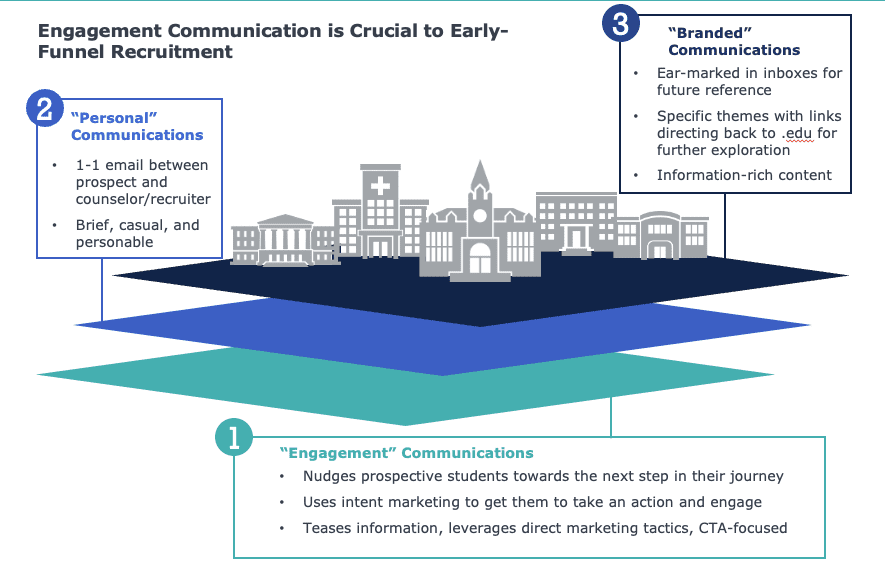Are you recalibrating your graduate and adult recruitment strategy?
In my time working in the graduate and adult enrollment terrain at EAB, one thing has become clear: change is the constant. Shrinking lead sources, declining confidence in higher education, and budget constraints are just a few of the challenges making it harder to fill programs that once basically marketed themselves.
But amid this volatility, lead generation fundamentals have remained consistent. Success doesn’t come from reinventing the wheel, but instead from recalibrating your strategy—adapting proven tactics to work around today’s challenges.
Here are four adjustments enrollment leaders are making to build stronger, more sustainable pipelines in this unstable environment.
1. Diversify your lead source pool
International student names and test-taker lists were once reliable lead sources, but they’re losing impact fast. International enrollment for the 2025-2026 academic year is predicted to drop by 30-40% due to tighter visa policies and concerns around safety and discrimination, while domestic GRE and GMAT test-takers have declined more than 60% since 2019.
Institutions keeping pace aren’t replacing those sources with a single alternative; they’re building a diversified source portfolio. A robust lead mix balances proven sources of intent-verified leads, like Appily Advance, with experimental channels such as short-form video marketing or Twitch that drive early-funnel awareness. The key is to treat lead sourcing as a dynamic investment that can evolve as performance data and market trends shift.
2. Prioritize high-intent leads (not just “known leads”) to stretch your budget
Recruiting and nurturing high-intent “known leads” (which include inquiries, alumni, or application starters) remains essential. These students already know your institution and typically convert at higher rates.
But to expand your top-of-funnel with more quality leads, incorporate additional high-intent sources beyond known leads. Supplement current student and alumni lists with leads from digital advertising and student-search platforms such as Appily Advance that filter for intent and readiness. In today’s overcrowded market, low-quality leads can drain both budget and time without delivering results. By shifting your budget toward students who have signaled intent, you can allocate resources more efficiently and build a pipeline that’s both responsive and cost-effective.
3. Engage early-funnel leads
While high-intent leads should be the cornerstone of your top-of-funnel strategy, most students are not yet familiar with your institution and may need more outreach to build awareness. Ignoring these early-funnel leads means missing out on a large share of potential enrollments. Sustained, year-round engagement ensures that even less-familiar prospects progress through the funnel, eventually becoming applicants in a future term.

The most successful student communication plan is layered. While personal and branded communication is important in nurturing students down-funnel, effective early-funnel campaign language focuses on engagement. This messaging spurs prospects to take some sort of action and continue learning about your institution. The goal is to build familiarity and trust long before a student is ready to apply.
4. Extend your nurture timeline
EAB data shows that more than a third of adult learners spend 12 months or more researching programs before applying. However, many institutions’ lead nurture programs don’t last even that long. One of our graduate and adult marketing experts “secret shopped” 50 institutions’ nurture programs, and found that almost a quarter of them ended outreach after just one month. At EAB, the lead nurture campaigns we build for partners typically last at least 20 months given adults’ extended decision timelines. These campaigns integrate personalized email, text, and digital channels with evergreen content that stays relevant year-round. Campaigns that acknowledge adult learners’ competing responsibilities, showcase real student success stories, and address cost and career outcomes directly are likely to attract students’ attention and keep it until they are ready to apply.
There are no silver bullets in enrollment marketing. But there are smarter ways to apply what’s already working. Diversify your lead sources, extend your nurture timelines, act quickly on high-intent leads, and keep engaging students in the early funnel. When enrollment teams continually recalibrate their strategy as the market shifts, they position themselves to thrive, no matter what tomorrow brings.

More Blogs

4 questions domestic students will ask before applying to your graduate program

When Grad PLUS disappears: What 8,000+ grad students said about paying for school
